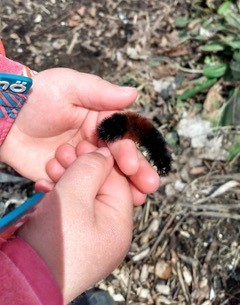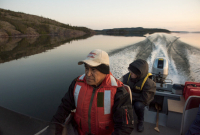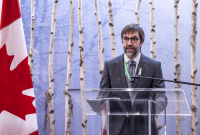Support strong Canadian climate journalism for 2025
Dragons, unicorns, and monarch butterflies. One of these things is not like the others — at least, not yet. But if Canada doesn’t take biodiversity loss seriously, that could change more quickly than we realize. The iconic butterfly, along with thousands of species large and small that we take for granted and rely on for our health and well-being, will exist only in the imagination of future generations.
While world leaders continue to meet about the loss of biodiversity worldwide at COP15 in Montreal, this is hitting home for me as a parent. Last Saturday, 3,500 people from countries around the world marched through the streets of Montreal to send a message to Canada’s leaders. As a parent, I'm calling on Canada to recognize and respect Indigenous rights and knowledge, make good on its commitment to protect at least 30 per cent of land and water in this country by 2030, invest in nature-based solutions and divest from activities that are harming nature.
Why is this so important to me? Because there’s a harsh reality I see through my kids’ eyes every day. Right now, my daughter can still experience the magic of a caterpillar transforming into a butterfly, bees gathering pollen, tadpoles growing into frogs, and she knows intuitively that she is part of nature, connected with all living things.

But that knowledge, that connection with the natural world, is rapidly becoming a memory. The most recent report on wildlife in Canada identifies 2,253 species that are at risk or no longer exist naturally, and 105 of those are not found anywhere else in the world. One in five species in Canada is at risk of disappearing, meaning that if we do not act to conserve them, they will disappear from Earth.
It’s more than “enjoying being in nature.” The connection between biodiversity loss and other crises we’re facing may not be immediately obvious, but it’s clear that as we continue to lose native species by destroying their habitats, the ripple effects to food security, severe weather events and climate change are strong and staggering.
The World Economic Forum ranks biodiversity loss as the third-greatest risk on a global scale in its 2022 report and highlights why it matters to human, economic, and planetary health. We know that nature-based solutions to climate change can capture up to 20 per cent of greenhouse gas emissions and help mitigate the effects of a warming planet, providing protection from extreme weather events. Urban forest cover can help cool cities by several degrees, making the difference between livable temperatures and extreme heat.
At its roots, biodiversity loss reflects a troubling worldview where the crucial and often fragile ecosystems we’re part of are seen as commodities to be used up, bought, sold, traded, or discarded.
We have a huge blind spot that has led to the kind of mess that’s happening in Ontario right now, where legislation permitting development in protected areas has been pushed into law despite opposition even from advocates calling for solutions to the housing affordability crisis the law is supposed to address. At the same time, land in the Greenbelt is being traded for piecemeal parcels of farmland like interchangeable Lego blocks.
In B.C., the destruction of old-growth forest continues, despite overwhelming evidence that older trees capture significantly more carbon than the seedlings that replace them. There are examples from every part of the country of practices and policies that need to change.
Across Canada, we have heard the rhetoric about the rights of Indigenous people, only to have those rights trampled on when they conflict with oil and gas development. While we are pleased to see the federal government promising $800 million over seven years to four Indigenous-led conservation initiatives and additional funding for a First Nations Guardians Network, this must be only the beginning if we are to successfully halt and reverse biodiversity loss while advancing the rights of Indigenous Peoples.
Commitments in words are meaningless if the status quo is allowed to continue. While I believe there are individual choices we can make that will help protect against further biodiversity loss, I know that the problem — and the solutions — need collective support.
That’s why parents like me from across the country are calling on our elected representatives to be bold, practical and visionary at COP15: to call for mechanisms for fair funding and accountability, to understand the need for urban biodiversity and equitable access to nature, to invest in nature-based climate solutions. Above all, to follow the lead of Indigenous Peoples and protect their rights, and commit to protecting at least 30 per cent of lands and waters by 2030. As parents, we need COP15 to be a meaningful step in protecting the interconnected web of life.
It’s about more than protecting a butterfly. The well-being of all our kids is at stake.
Marianne Ariganello is a mother, scientist and organizer with For Our Kids Ottawa-Gatineau, a group of parents and guardians working together to help families advocate for climate justice and a better future for all generations. For Our Kids is a network of parent-led groups across Canada working for climate justice.






Comments